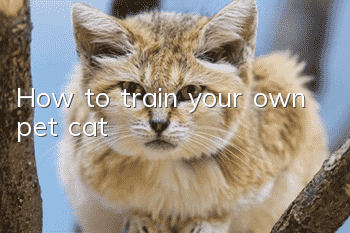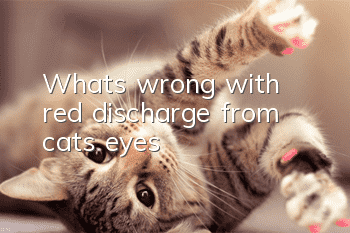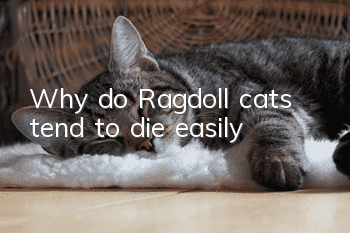How to train your own pet cat?

Whenever it comes to pet cat training, many people think that exercise is not necessary. Although cats don't exercise like dogs, there are some training methods that can help you keep your cat active and active. So, how to train your own pet cat?
1. Train pet cats to start from the doll, and correct mistakes by grasping the current situation
The cat must be educated immediately at the scene of the mistake. Because most cat owners have to go to work, this may not be easy, making it more difficult to correct their cats’ misbehavior. Training should begin when the cat is young. It's very difficult to correct bad habits in an adult cat, but it's easier to prevent them in the first place. However, with persistence, any cat can learn some simple behavioral rules.
Training is best started within a few days of bringing your cat home. Keep a water gun or a sounder handy during training (you can put some coins in an aluminum can). Whenever your cat climbs on a chair or grinds its teeth on furniture, spray it with a squirt gun or shake a clicker next to it. If you can't keep an eye on it, limit its range before leaving home. Do not punish cats corporally, as corporal punishment will only make the cat afraid of its owner and lose trust.
2. Training pet cats to hold objects
Cats are capable of holding objects in their mouths, and we often see cats running away with their babies in their mouths. Parents can also train their pet cats to hold objects. It is not difficult to spend some time training.
First of all, put a special collar on the cat during training, so that parents can control the cat's actions during training. The parent holds the collar with one hand and an object for the cat to hold with the other hand. The parent gives the "pick" command and forces the object into the cat's mouth. Then pet the cat with your hands to encourage it to do a great job. Then give the "release" command and at the same time remove the object from the cat's mouth, then pet it and take out delicious food as a reward for the cat. After repeated training for a period of time, the cat will form a conditioned reflex, and it will know that as long as it completes the actions of holding and spitting out the object, it will get food. It will willingly accept the training and complete the action.
Thirdly, after a period of training, cats can master the movement of holding objects. Next, the parent can shake the object to be picked up in front of the cat's eyes to fully attract the cat's attention and curiosity, then throw the object a few meters away and give the "hold" command at the same time, allowing the cat to pick up the object by itself. The cat may not cooperate with the early training, so the owner needs to guide or force the cat to pick up the object. Then walk to the spot, the parent gives the command "spit", and then sticks out the object for the cat, and then strokes and rewards the cat with food. After training for a period of time, the cat will master the entire holding movement.
3. Train pet cats to come and go freely
Use a tickle post to train your cat. Whenever your cat looks like he wants to scratch the furniture, warn him and then gently place his paws on the scratching post. Rub some catnip on the post to make it more attractive to cats. Manufacturers produce scratching posts in many different designs. This model has a raised platform for the cat to sit on and a ball for the cat to play with.
Use the trap door: The trap door should be placed about 15 cm above the ground. When training a cat, open the trap door slightly and put a small amount of food on the other side of the door to lure the cat out through the door. When a cat wants to get out, it quickly learns to push the door open on its own.
4. Training pet cats to take baths
If you want your cat to come into contact with water normally, the owner must train the cat to come into contact with water from an early age. Be gentle when bathing your cat so that it doesn't become afraid of water. Of course, you should not force the cat to like water. Instead, you should slowly guide the cat to contact the water slowly, let it know that water is not scary, and slowly allow the pet cat to have normal contact with water.
5. Training pet cats to use the toilet flush
Before adjustment, place a plastic board (or replace it with a wooden board) under the toilet seat, and then spread an appropriate amount of sand, furnace ash or sawdust and other bedding materials on the plastic board or wooden board. When you find that your cat wants to defecate, take it to the toilet immediately. Soon, it will defecate on its own. After several patient trainings, the cat gradually formed the habit of defecating on the toilet with padding. After that, the padding on the plastic board or wooden board was gradually reduced. In the process, the cat quickly learned that it should stand on Defecate and urinate on the toilet seat instead of standing on the lower padding inside the toilet. Then gradually remove all the bedding material and drill a hole in the plastic board to allow urine to drain. If the bedding is removed too early and the cat no longer wants to defecate on the toilet seat, you will have to start training again. In short, wait until your cat gets into the habit of standing on the toilet seat to relieve himself before removing the plastic or wooden board.
During the training process, you should also pay attention to several details. First of all, replace the bedding that has been soiled by urine or feces every day, and always keep the toilet clean. Doing so can speed up the training process; secondly, during training, it is prohibited for people to use the toilet at the same time, especially when cats urinate and defecate on the toilet. Do not disturb or obstruct it; thirdly, some cats may accidentally slip and fall into the toilet. Such cats generally will not go to the toilet to relieve themselves. At this point, the owner has to start training from scratch until the cat learns to defecate in the toilet.
6. Training pet cats to jump through rings
The hoop used to train cats to jump can be made of bamboo embroidery rules, or thick iron wire can be used to tie it into an iron hoop with a diameter of about 30 cm. During training, first place the ring straight on the ground, between the person and the cat, and continuously say "jump" to the cat.dquo;Instructions. If the cat can walk through the ring, it should be rewarded with food immediately; if it comes around from the edge, it should be given a soft scolding. After repeated training, the cat will walk through the ring as soon as it hears the "jump" command.
Then you can gradually increase the height of the hoop from the ground to force the cat to jump over the hoop. Each time the cat jumps over, the cat will be rewarded. At the beginning, do not raise the hoop too high. Once the hoop is raised, the cat may not dare to jump. The owner can put food in the hoop to lure the hoop, and keep giving the "jump" command. The cat only needs to jump once, and it will be easy to jump in the future. too much.
After training for a period of time, gradually reduce the food reward. The training is successful until the cat can jump from a ring 30-60 cm above the ground as soon as the owner gives the "jump" command without food reward.
7. Training pet cats to shake hands
(1) Prepare food: Prepare some food that cats like to eat, such as beef jerky or fish fillets, etc., put some meat scent on your right finger, then call the cat over, extend your right hand in front of the cat to let it smell the food fragrance.
(2) To induce the cat: gently say to the cat: shake hands, shake hands. When the cat smells the fragrance of your fingers, it will naturally stretch its head over. At this time, if you raise your hand, the cat will also stand up and stretch out its front paws.
(3) Pay attention to the command: You can take the opportunity to hold the cat's right paw and say "shake hands" while passing the food to the cat with your left hand. When shaking hands, you can gently shake its front feet and speak kindly, and so on, several times a day.
(4) Follow-up reinforcement: From now on, you only need to use food occasionally to consolidate your training. In normal times, as soon as you say "shake hands", the cat will naturally stretch out its right paw to shake hands with you.
- What to do if your cat has lip ulcers?
- Three steps to train a cat to pretend to be dead, you can learn it in 8 seconds!
- Why does the cat suddenly urinate everywhere?
- Cats always drop a poop on the ground
- Will a cat's teeth grow back if they are broken?
- Will you get rabies if you are bitten by a cat? Do you need a rabies vaccine?
- Are ragdoll cats with point colors scarce? Ragdoll cat breeds!
- Why does a Persian cat vomit after eating food?
- How to tell if your cat is full
- Can male and female cats be kept together?



